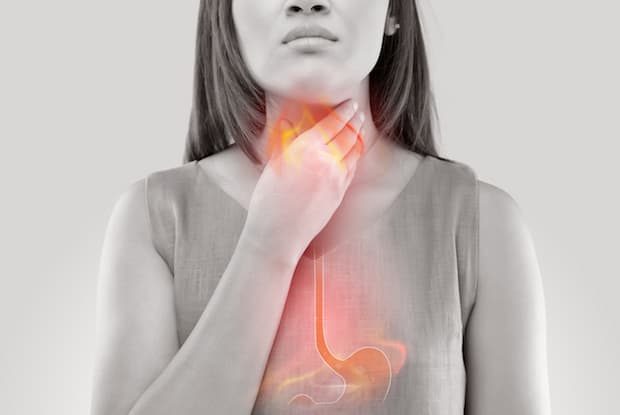Table of Contents
II. The Gastroparesis Recovery Diet
VI. Fill Up on Fruits and Vegetables
What is Gastroparesis?
Gastroparesis is a serious gastrointestinal disorder that can lead to painful and uncomfortable symptoms. Gastroparesis affects the movement of the stomach. In a normally functioning stomach, the muscles of the propel food through the intestines. When gastroparesis is present, these muscles are slowed, which prevents the stomach from emptying properly. Gastroparesis risk factors include the use of opioid pain relievers, antidepressants, high blood pressure medications, and allergy medications.
Medications may cause this condition, but this disorder is most common in people with diabetes. Living with diabetes can have several long-term effects on the body, including nerve damage. [1] In the case of gastroparesis, the vagus nerve begins to malfunction. This is an important nerve in the body responsible for communication between the brain and tissues and organs in the body. This nerve is responsible for the communication between the brain and the gut. If this nerve is damaged, then gastroparesis may occur. [2]

Symptoms of gastroparesis can include:
- Abdominal bloating
- Acid reflux
- Vomiting undigested food
- Weight loss and malnutrition
- Nausea
- Vomiting
- Changes in blood sugar levels
- Lack of appetite
In many cases, medications like Motilium (domperidone) can help with symptoms of gastroparesis. Motilium increases the muscle movement in the intestines, improving gastroparesis. It is essential to seek help for this condition because it can lead to malnutrition, severe dehydration, and unpredictable blood sugar changes in the case of diabetes. Medications can help with this disorder, but there are several dietary changes a person can make to improve gastroparesis. Read on to learn more about diet tips while living with this intestinal disorder. [1]
Get savings updates for Motilium
The Gastroparesis Recovery Diet
Typically, normal muscle contractions empty the stomach within 90-120 minutes after eating. If these contractions become sluggish, food can be left in the stomach, and serious symptoms can occur. Once medications are prescribed to improve intestinal movement, a person must alter their diet to improve digestion. This recovery diet is recommended by physicians to help gastroparesis. This diet has three distinct steps and your doctor will let you know when you can advance to the next step. [3]
Step 1: This step requires the consumption of lots of liquids that will leave the stomach quickly. Eating and drinking liquids prevent the body from becoming dehydrated and supply the body with salts and minerals. Because broths and liquids are generally low-fat, there is not as many restrictions on this step. Consult your doctor for more information about a proper meal plan for step 1.
Step 2: More calories are implemented in this step. You can consume small amounts of dietary fat, which should be limited to 40 grams of fat a day.
Step 3: This step is designed for long-term maintenance and should be permanently implemented in a person’s lifestyle. Step 3 involves 50 grams of fat a day and limiting fibrous foods because they are difficult to digest. [3]
Eating Techniques
Those with gastroparesis may need to be more mindful of how they eat. This extends not only to what you put in your mouth but also your posture while eating and portion sizes. It is recommended that a person recovering from gastroparesis should eat 5-8 small meals a day instead of the typical three. This allows the stomach time to digest the food properly and prevent too much food in the intestines.

It may sound redundant, but you must chew your food fully before swallowing. We all must chew foods while eating, but those with gastroparesis need their food to be fully pulverized. Big chunks of swallowed food can further irritate the intestines and hinder stomach-emptying. If food enters the stomach in a liquid state, it can digest better and improve symptoms. Eating while sitting up is also important because you can use gravity to your advantage, so food can enter the stomach easier. This also aids proper digestion.
Along with these techniques, it is also essential to drink plenty of water to prevent the digestive system from becoming dehydrated. Avoiding alcohol is also recommended because alcohol consumption can cause further dehydration and constipation. [4]
Avoid Saturated Fat
Avoiding saturated fat is essential in treating gastroparesis. Several studies have found that eating foods high in saturated fat can trigger gut inflammation. It is recommended to avoid eating too much dairy or fatty meats because foods high in fat take longer to digest. If fat hangs around in the stomach due to gastroparesis, then bezoars can form. Bezoars are solid masses of indigestible material that can accumulate in the digestive tract and cause blockages. [5]
Scientists have found that there is a rise in bowel diseases in the United States due to our high-fat diets and sedentary lifestyles. Saturated milk fats and trans-fat added to ice cream and candies contribute to bowel disease more than fatty meats. Milk fats also feed gut bacteria and allow it to bloom, leading to infections and complications. [6]
The following foods are high in saturated fats:
- Coconut and palm oils
- Full fat dairy products (cream, milk, yogurt, cheese)
- Butter, lard, ghee, margarine, goose fat
- Fatty meats like lamb chops
- Milk and white chocolate, cakes, biscuits, pastries, pies [7]

Eat High Protein Foods
In severe cases of gastroparesis, malnutrition and weight loss can occur. Because of this, it is essential to get proper nutrition when eating. You may have to avoid fats, but there are still plenty of other foods you can enjoy, including dairy-free and fat-free substitutes. A successful gastroparesis diet includes lots of high-protein foods and easy-to-digest vegetables. [8]
Some recommended proteins and high-fat dairy alternatives include:
- Peanut butter
- Tofu
- Chicken
- Fish
- Lean meats
- Soy, rice, almond milk
- Eggs
- Protein smoothies
- Skim milk [8]
Fill Up on Fruits and Vegetables
It is essential to clarify with your doctor or dietician about which fruits and vegetables are beneficial to a gastroparesis-friendly diet. It is advised not to eat a lot of raw vegetables because they are high in fibrous material. The fibers in raw celery, for example, are more challenging for the stomach to digest. If the fibrous material from fruits or vegetables cannot be digested, they can clump together to form bezoars in the intestinal tract. It is best to stick with easily digested vegetables like cooked zucchini. [8]
Recommended fruits:
- Applesauce
- Bananas
- Grapefruit
- Honeydew or cantaloupe
- Peaches or pears
Recommended cooked vegetables:
- Peppers
- Sweet or white potatoes (peeled)
- Squash
- Carrots
- Zucchini [8]
The content in this article is intended for informational purposes only. This website does not provide medical advice. In all circumstances, you should always seek the advice of your physician and/or other qualified health professionals(s) for drug, medical condition, or treatment advice. The content provided on this website is not a substitute for professional medical advice, diagnosis or treatment.
